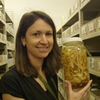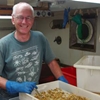Other Names
- Ambidextrous Burrower
General Description
Rostrum short. Claws (chelipeds) equal and similar in both sexes; fourth segment (merus) unarmed, carinate on upper margin; sixth segment (propodus) carinate on upper and lower margins; fixed finger with proximal tooth; last segment (dactylus) usually smooth. Tail fan (telson) with concave posterior margin, much shorter than uropods. Body up to 8.5 cm length.
Biology
Ghost shrimps dig deep permanent burrows on mud flats intertidally and on deeper sediment. In places like Western Port, the burrows can be found alongside seagrasses. Each burrow has two openings, one funnel-shaped down which water is drawn for ventilation, and another with a volcano built of mud excavated by the shrimp and dumped outside.
Habitat
Mudflats, often estuarine, intertidal-9 m depth.
Soft substrates
Distribution guide
East Indo-west Pacific Oceans (Maldive Archipelago). Southern Australia, excluding Tasmania.
Species Group
Prawns, shrimps, lobsters › Ghost and mud shrimps
Depth
Shore (0-1 m)
Shallow (1-30 m)
Water Column
Max Size
8.5 cm
Diet
Organic matter
Harmful
Not harmful but a nip from large claws could be painful
Commercial Species
No
Global Dispersal
Recorded in Australia
Species Code
MoV 1006
Conservation Status
- DSE Advisory List : Not listed
- EPBC Act 1999 : Not listed
- IUCN Red List : Not listed






